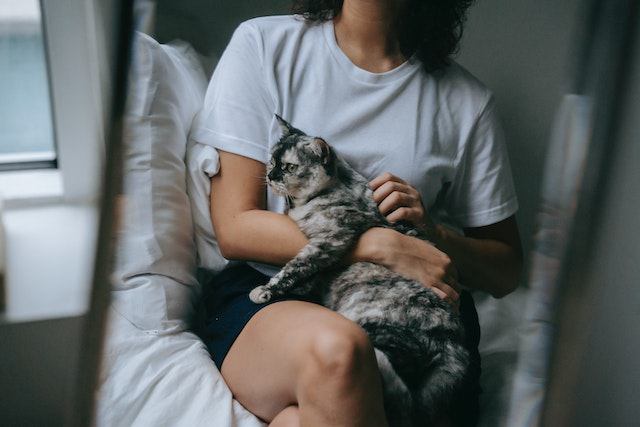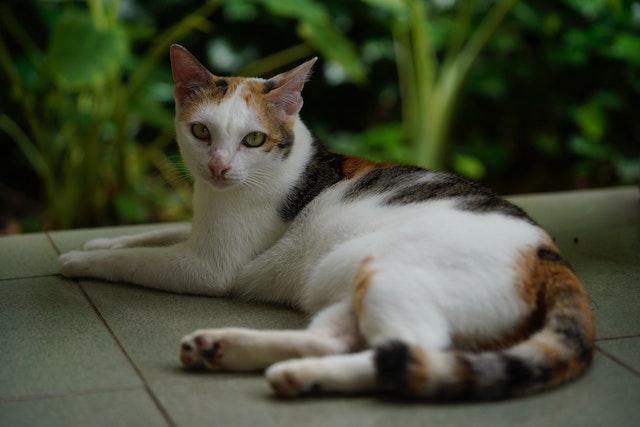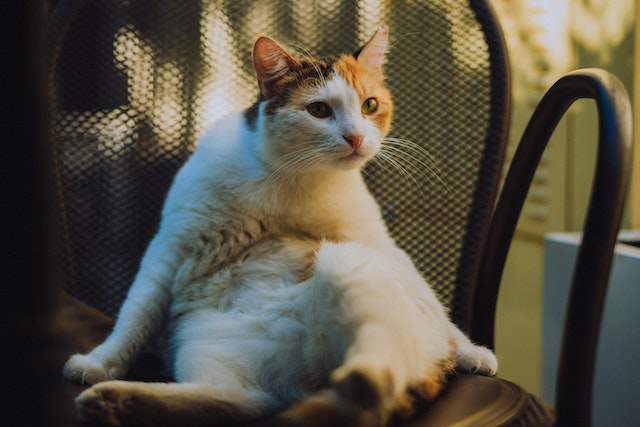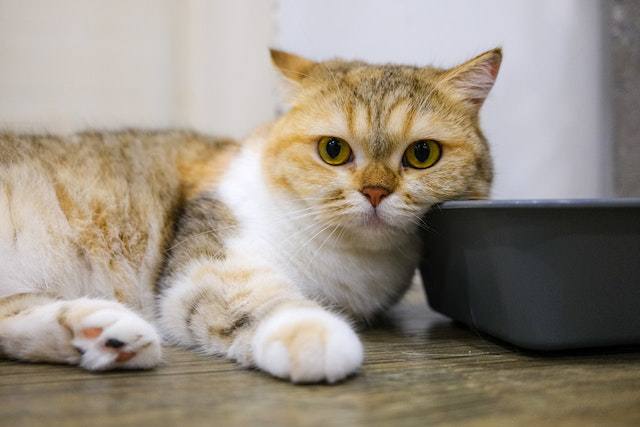10 Potential Reasons For Cat Twitching Leg With Tips

Hey there, fellow cat lovers! Have you ever noticed your cat twitching leg while they’re snoozing or even during playtime? Well, you’re not alone!
In this blog post, we’re diving into the fascinating world of cat-twitching legs, exploring the possible reasons behind this adorable mystery.
What Is a Cat Twitching Leg?
Cat leg twitching refers to involuntary muscle contractions or spasms in a cat’s legs. It can manifest as brief, repetitive movements or as prolonged shaking of the limbs.
Twitching can occur in one or multiple legs and may affect both the front and hind limbs. Common causes of cat leg twitching include muscle fatigue, nerve irritation, stress, or neurological conditions.
Cats may exhibit leg twitching while awake or during sleep. In some cases, leg twitching may be accompanied by other symptoms such as muscle weakness, pain, or difficulty walking.
A veterinary evaluation is necessary to determine the underlying cause and provide appropriate treatment for cat leg twitching.
Common Causes of Cat Leg Twitching

The following are some common causes of cat twitching leg:
1. Muscle Spasms
Muscle spasms can be a common cause of a cat twitching leg. These spasms occur when the muscles contract involuntarily, leading to twitching or jerking movements in the legs.
Muscle spasms in cats can be caused by various factors including dehydration, nutritional deficiencies, nerve damage, or underlying medical conditions.
To address this situation, it is important to identify and address the underlying cause of the muscle spasms.
This may involve providing proper hydration, ensuring a balanced diet, and seeking veterinary advice for a thorough examination and appropriate treatment.
2. Medication Side Effects
Medication side effects can be a common cause of a cat twitching leg. This occurs when certain medications affect the neurological system, leading to involuntary muscle contractions.
To address this situation, it is essential to consult with a veterinarian to determine if the twitching is indeed a side effect of medication.
The vet may adjust the dosage or switch to a different medication to alleviate the twitching.
It is important to closely monitor the cat’s behavior and report any changes or concerns to the veterinarian for appropriate management.
3. Neurological Disorders
Neurological disorders can be a common cause of cat twitching leg. These disorders can affect the nerves and pathways that control muscle movement, leading to involuntary muscle contractions and twitches.
This can occur due to conditions such as feline hyperesthesia syndrome, epilepsy, or nerve damage. To address this situation, it is crucial to consult a veterinarian for a proper diagnosis and treatment plan.
They may recommend medications to control seizures or manage underlying neurological conditions. Additionally, creating a calm and stress-free environment for the cat can help minimize episodes of leg twitching.
Learn more about identifying a sick cat.
4. Trauma
Cat twitching leg can be caused by trauma, such as accidents or falls, that result in nerve damage. When trauma occurs, it can disrupt the normal functioning of the nerves that control muscle movement in the legs.
This disruption can lead to involuntary twitching or spasms. To address this situation, it is important to seek veterinary care to assess the extent of the trauma and determine the appropriate treatment.
Treatment options may include pain management, physical therapy, or surgery, depending on the severity of the nerve damage.
Early intervention and proper care can help alleviate the twitching and improve the cat’s quality of life.
5. Injury
Injuries can be a common cause of cat twitching leg. This occurs when the cat experiences trauma or damage to its leg, resulting in involuntary muscle contractions or spasms.
The injury can be caused by accidents, falls, or even bites from other animals. To address this situation, it is important to first assess the severity of the injury by examining the leg for any visible wounds or swelling.
If the injury seems minor, providing a safe and quiet space for the cat to rest and recover may be sufficient.
However, if the injury appears severe or if the twitching persists or worsens, it is crucial to seek veterinary assistance for a proper diagnosis and treatment plan.
6. Feline Hyperaesthesia Syndrome
Feline hyperaesthesia syndrome is a relatively common cause of cat twitching leg.
It is a neurological disorder that affects cats, causing them to exhibit abnormal behaviors such as twitching or rippling of the skin, excessive grooming, and sensitivity to touch.
The exact cause of this syndrome is still unknown, but it is believed to involve a combination of genetic and environmental factors.
To address this situation, it is important to consult with a veterinarian who can diagnose the syndrome based on the cat’s symptoms and behavior.
Treatment options may include medications to manage the cat’s anxiety or pain, environmental modifications to reduce stress, and behavioral therapy to help the cat cope with the condition.
7. Metabolic Derangements
Metabolic derangements can be a common cause of cat twitching legs. These derangements occur when there is a disruption in the normal metabolic processes of the body, leading to abnormal nerve function.
One example is hypocalcemia, a condition characterized by low levels of calcium in the blood, which can cause muscle spasms and twitching.
To address this situation, it is crucial to identify the underlying metabolic disorder through diagnostic tests.
Treatment may involve correcting the imbalances through dietary changes, supplements, or medications, as prescribed by a veterinarian.
Regular monitoring and follow-up are necessary to ensure the cat’s condition improves and to prevent further complications.
8. Electrolyte Imbalance
Electrolyte imbalance can be a common cause of cat twitching leg. This condition occurs when there is a disruption in the levels of electrolytes, such as potassium, calcium, and magnesium, in the cat’s body.
Electrolytes play a crucial role in nerve and muscle function, and imbalances can lead to muscle twitches or spasms.
To address this situation, it is important to identify the underlying cause of the electrolyte imbalance, which can be due to various factors like kidney disease or certain medications.
Treatment may involve correcting the electrolyte levels through dietary adjustments or supplementation, as well as addressing the underlying cause of the imbalance.
9. Encephalomyelitis
Encephalomyelitis is a common cause of cat twitching leg, which refers to inflammation of the brain and spinal cord. It can occur due to various factors, including viral infections, autoimmune disorders, or exposure to toxins.
The inflammation disrupts the normal functioning of the nervous system, leading to involuntary muscle contractions and twitching in the legs.
To address this situation, it is important to seek veterinary care promptly for a proper diagnosis and treatment plan.
Treatment options may include medications to reduce inflammation, manage symptoms, and address any underlying causes.
10. Seizure Disorders Like Epilepsy
Seizure disorders, such as epilepsy, can be a common cause of cat twitching legs. These disorders occur due to abnormal electrical activity in the brain.
During a seizure, a cat’s muscles may contract uncontrollably, leading to twitching or jerking movements in the legs.
To address such a situation, it is crucial to ensure the cat’s safety by removing any objects that could harm them during the seizure.
It is also important to avoid restraining the cat or placing any objects in their mouth. If a cat experiences frequent or prolonged seizures, it is essential to consult a veterinarian for a proper diagnosis and treatment plan.
When Cat Leg Twitching Might Be a Cause For Concern

Cat leg twitching can be a cause for concern for the owner in certain situations.
One possible cause for concern is if the leg twitching is accompanied by other symptoms such as weakness, loss of coordination, or difficulty walking. This could indicate a neurological issue or a problem with the cat’s muscles or nerves.
Another cause for concern is if the leg twitching is persistent and does not resolve on its own after a short period of time. In this case, it may be necessary to seek veterinary attention to determine the underlying cause.
Additionally, if the leg twitching is accompanied by pain or discomfort, it is important to consult a veterinarian for proper diagnosis and treatment.
Finally, if the leg twitching is sudden and severe, it is crucial to seek immediate veterinary care as it could be a sign of a serious medical emergency.
Diagnosis of Cat Twitching Leg Issue

Cat leg twitching can be caused by various factors, including neurological disorders, muscle spasms, or even stress.
To diagnose the underlying cause, a veterinarian will typically perform a thorough physical examination, including observing the cat’s gait and muscle tone.
They may also conduct additional tests such as blood work, X-rays, or even an electromyogram (EMG) to assess the nerves and muscles.
The diagnosis will depend on the specific symptoms observed and the results of these tests, helping the veterinarian determine the appropriate treatment plan for the cat’s leg twitching.
Treatment Options for Cat Twitching Leg Excessively
Excessive twitching in a cat’s leg can be a cause for concern, as it may indicate an underlying medical condition or discomfort.
It is important to consult with a veterinarian to determine the cause of the twitching and to discuss appropriate treatment options.
Here are some potential treatment options for a cat twitching leg excessively:
1. Veterinary Examination: The first step in addressing excessive twitching in a cat’s leg is to have a thorough veterinary examination. The vet will assess the cat’s overall health and conduct a physical examination to identify any underlying medical conditions that may be causing the twitching.
2. Diagnosis of the Underlying Cause: Once the veterinary examination is complete, the vet may recommend further diagnostic tests to identify the underlying cause of the excessive twitching. These tests may include blood work, X-rays, or other imaging techniques to rule out any neurological or musculoskeletal issues.
3. Medication: Depending on the underlying cause identified, the veterinarian may prescribe medication to alleviate the twitching and manage any related symptoms. For example, if the twitching is due to pain or inflammation, the vet may prescribe pain relievers or anti-inflammatory medications.
4. Environmental Changes: In some cases, environmental factors may contribute to a cat’s excessive leg twitching. Ensuring a stress-free and comfortable environment for the cat can help reduce twitching episodes. This may involve providing a quiet and safe space, minimizing exposure to loud noises or sudden movements, and maintaining a consistent routine.
5. Nutritional Changes: Diet can play a role in a cat’s overall health and well-being. In some cases, specific dietary adjustments may be recommended to address any nutritional deficiencies or imbalances that could be contributing to the twitching.
6. Physical Therapy and Rehabilitation: If the twitching is related to a musculoskeletal issue or injury, the veterinarian may recommend physical therapy or rehabilitation exercises to help strengthen the affected leg and improve mobility.
7. Behavioral Modification: In certain cases, excessive twitching may be related to anxiety or stress. Behavioral modification techniques, such as environmental enrichment, play therapy, or relaxation techniques, may be recommended to help reduce stress and alleviate the twitching.
Learn more about cat health concerns.
Related Questions
Why does my cat’s leg twitch sometimes when they’re sleeping?
Cats often experience muscle twitches during sleep, which is a normal phenomenon. It’s similar to humans experiencing twitches or jerks during the REM (rapid eye movement) phase of sleep. These twitches can be a result of the brain sending signals to the muscles, causing them to contract momentarily. So, if you notice your cat’s leg twitching occasionally while they sleep, there’s typically no need to worry.
Is it normal for my cat’s leg to twitch while they’re awake?
Yes, it can be normal for cats to experience leg twitches while they’re awake as well. Similar to humans, cats may have involuntary muscle contractions or twitches due to various reasons. It could be a result of excitement, anticipation, or even a response to external stimuli. However, if you notice excessive or persistent twitching while your cat is awake, it’s best to consult a veterinarian to rule out any underlying health issues.
Can stress or anxiety cause my cat’s leg to twitch?
Yes, stress and anxiety can potentially contribute to muscle twitches in cats. Just like humans, cats can experience stress or anxiety in certain situations, which may manifest as physical symptoms such as twitching legs. If you notice that your cat’s leg twitches are accompanied by other signs of stress or anxiety, such as excessive grooming, hiding, or changes in appetite, it’s important to address the underlying cause and provide a calm and reassuring environment for your furry friend.
Are there any medical conditions that can cause cat leg twitching?
Yes, certain medical conditions can cause leg twitching in cats. Neurological disorders, such as feline hyperesthesia syndrome or seizures, can result in involuntary muscle movements, including leg twitches. Additionally, nerve injuries, muscle spasms, or even certain medications may also contribute to twitching in cats. If you’re concerned about your cat’s leg twitching and it appears to be more frequent or severe, it’s advisable to consult a veterinarian for a thorough examination.
Should I be worried if my cat’s leg twitches excessively or continuously?
Excessive or continuous leg twitching in cats may indicate an underlying health issue and should not be ignored. If your cat’s leg twitches are disrupting their daily activities, causing them discomfort, or accompanied by other concerning symptoms like weakness or loss of coordination, it’s crucial to seek veterinary attention promptly. A veterinarian will be able to assess your cat’s overall health and conduct any necessary tests to determine the cause of the excessive twitching.
How can I help my cat if their leg twitches are bothering them?
If your cat’s leg twitches are bothering them, there are a few things you can do to help. Firstly, create a calm and stress-free environment for your cat by providing a quiet and comfortable space for them to rest. Engaging your cat in interactive play sessions and providing mental stimulation can also help alleviate stress and anxiety. Additionally, maintaining a nutritious diet and regular exercise routine can contribute to your cat’s overall well-being. If the twitching persists or worsens, consulting a veterinarian is always recommended for proper diagnosis and treatment.
Conclusion
In conclusion, if you’ve ever wondered why your cat’s leg twitches during sleep, rest assured that it’s completely normal behavior.
Just like us humans, cats experience different stages of sleep, including REM sleep, where muscle twitches can occur.
So, next time you see your furry friend’s leg twitching, remember that they’re just enjoying a good snooze and dreaming of chasing mice in their feline wonderland.
